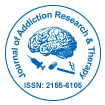Opioid Use Disorder: Signs and Symptoms.
Received: 21-Dec-2021 / Manuscript No. jart-22-50352 / Editor assigned: 23-Dec-2021 / PreQC No. jart-22-50352(PQ) / Reviewed: 04-Feb-2022 / QC No. jart-22-50352 / Revised: 09-Feb-2022 / Manuscript No. jart-22-50352(R) / Accepted Date: 11-Feb-2022 / Published Date: 16-Apr-2022 DOI: 10.4172/2155-6105.100454
Opioid use disorder is the use of drugs despite harmful consequences. This disorder includes drug insensitivity to opioids, strong yearning to use drugs, difficulty in reducing the usage of opioids. The withdrawal symptoms may include trouble sleeping, nausea, muscle aches, diarrhea. Diacetylmorphine, morphine, hydrocodone, dihydrocodeine, fentanyl, oxycodone, codeine are also present in opioid. Diacetylmorphine is also known as heroin or diamorphine. It is used as a psychoactive drug. It includes side effects such as decreased breathing, drowsiness, addiction. Its medical purposes include pain medication such as trauma, post-surgical pain or heart attack. Oxycodone is used for treatment of moderate to severe pain [1]. It is highly addictive. Oxycodone side effects include swelling of hands, feet or lower legs, Seizures, difficulty in breathing, hallucination, dizziness, mood changes, Hives, sweating, fast or slow heartbeat, nausea, constipation. Hydrocodone is used as cough suppressant. It is present in various formulations. Hydrocodone mostly include acetaminophen or ibuprofen. Fentanyl is used as pain medication together with other medications such as anesthesia. It is used as psychoactive drug at times combined with cocaine or diacetylmorphine. Its overdose effects are neutralized with naloxone. Its side effects include nausea, constipation and sedation. Serious side effects include hypoventilation, hallucinations, hypotension and serotonin syndrome. The factors that increase respiratory depression are high fentanyl doses, sleep, decreased CO2 levels, respiratory acidosis, renal insufficiency and decreased blood flow to the liver. People with opioid use disorder are treated with methadone or buprenorphine. Adverse side effects include constipation, hormone imbalance, effects on human performance. Methadone is a synthetic opioid used for pain management and addiction treatment [2-4]. Withdrawal symptoms include physical and cognitive symptoms. Physical symptoms include dilated pupils, yawing, sneezing, tremors, elevated pain sensitivity, hypertension, fever, sensitivity to light, restlessness, aches in joints or legs and vomiting. Cognitive symptoms include visual hallucinations, panic disorder, anorexia, paranoia, auditory hallucinations and depression. Overdose of methadone show symptoms such as constricted pupils, spasms, sleepiness, pale skin, nausea, unconsciousness and sedation. Buprenorphine used in treatment of pain and opioid addiction. Adverse effects of buprenorphine include neural inhibition, postural hypotension, shrinking of the pupils, dry mouth, central nervous system effects, memory loss and dizziness. People with addictive disorders are treated with addiction medicine. It deals with diagnosis, treatment, prevention and recovery against the addiction. Opioid overdose causes fluid accumulation in the lungs, decreased heart rate, hypothermia, reduced breathing, altered level of consciousness and death. Opioid withdrawal symptoms include agitation, cravings, fast heart rate, abdominal cramps, increased tearing, muscle aches, anxiety and shivering [5]. Opioid intoxication symptoms are somnolence, bradycardia, slurred speech, hypokinesis, low blood pressure, confusion and reduced perception of pain. Certain medical condition that occurs due to opioid use disorder is infection, systemic effects, overdose and mortality. Contaminated drug use leads to infections such as cellulitis, endocarditis, osteomyelitis etc. Inadequately sterilized injection drug use may cause bloodborne infection such as HIV; Hepatitis B and Hepatitis C. Bacterial infections such as pneumonia & tuberculosis are also caused. Systemic effects include opioid-induced bowe syndrome, opioid-induced hyperalgesia, opioid-associated liver fibrosis, opioidrelated leukoencephalopathy, opioid amnestic syndrome. Opioid overdose is treated with Naloxone. It is given by intravenous, intranasal or intramuscular. Naloxone prevents the activation of receptors.
References
- Webster LR (2017) Risk Factors for Opioid-Use Disorder and Overdose. Anesth Analg 125:1741-1748.
- Hagemeier NE (2018) Introduction to the opioid epidemic: the economic burden on the healthcare system and impact on quality of life. Am J Manag Care 24(10 Suppl):S200-S206.
- Peters-Watral B (2019) Opioid use disorder and chronic pain: challenges for palliative care practice. Int J Palliat Nurs 25:453-457.
- Han B, Compton WM, Blanco C, Crane E, Lee J, et al. (2017) Prescription Opioid Use, Misuse, and Use Disorders in U.S. Adults: 2015 National Survey on Drug Use and Health. Ann Intern Med 167:293-301.
- Salsitz EA (2016) Chronic Pain, Chronic Opioid Addiction: a Complex Nexus. J Med Toxicol 12:54-57.
Indexed at, Google Scholar, Crossref
Indexed at, Google Scholar, Crossref
Indexed at, Google Scholar, Crossref
Indexed at, Google Scholar, Crossref
Citation: Johnson C (2022) Opioid Use Disorder: Signs and Symptoms. J Addict Res Ther 13: 454. DOI: 10.4172/2155-6105.100454
Copyright: © 2022 Johnson C. This is an open-access article distributed under the terms of the Creative Commons Attribution License, which permits unrestricted use, distribution, and reproduction in any medium, provided the original author and source are credited.
Share This Article
Recommended Journals
Open Access Journals
Article Tools
Article Usage
- Total views: 1071
- [From(publication date): 0-2022 - Feb 22, 2025]
- Breakdown by view type
- HTML page views: 748
- PDF downloads: 323
